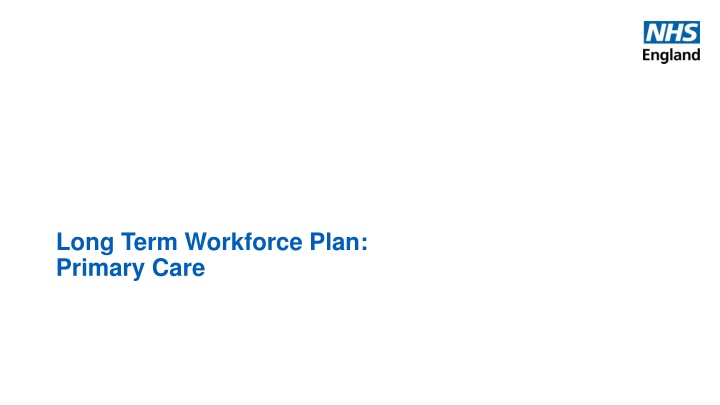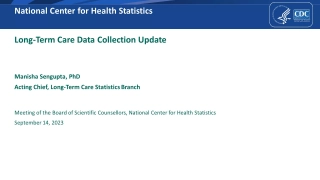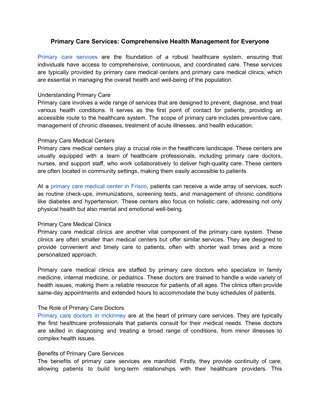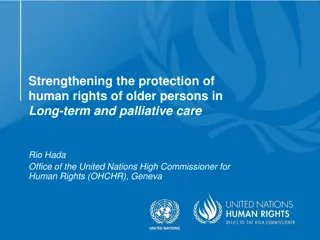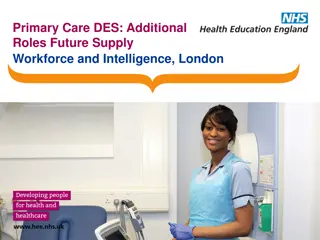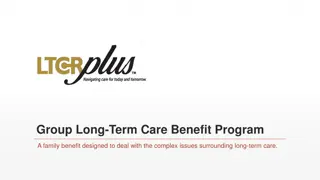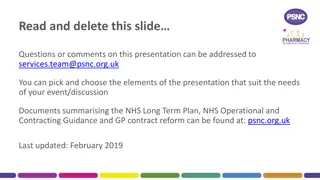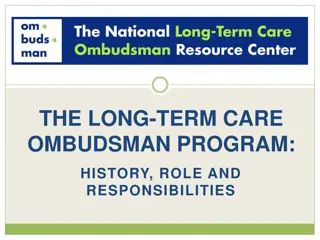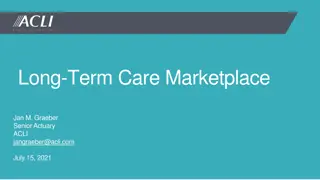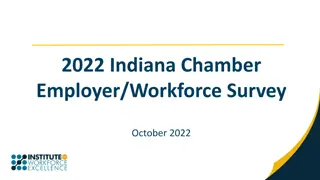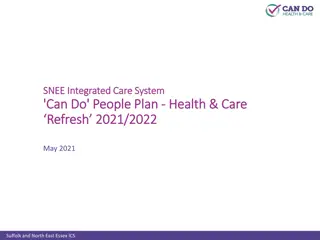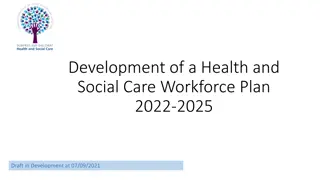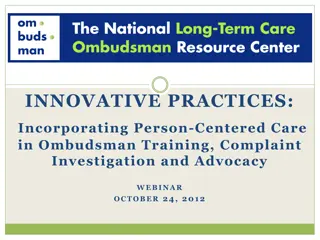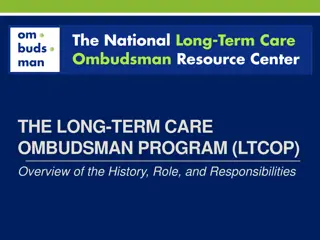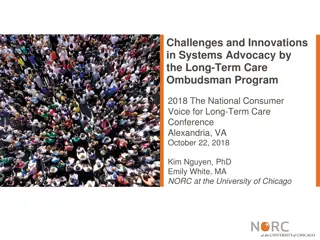Long-term Workforce Plan in Primary Care
Scene setting for the NHS workforce planning, highlighting the impact of the COVID-19 pandemic, projected workforce shortfalls, stakeholder perspectives, and proposed themes for primary care development. The case for change emphasizes key projections, challenges, and factors influencing future workforce needs, urging coordinated action to address workforce gaps and changing care models.
Download Presentation

Please find below an Image/Link to download the presentation.
The content on the website is provided AS IS for your information and personal use only. It may not be sold, licensed, or shared on other websites without obtaining consent from the author.If you encounter any issues during the download, it is possible that the publisher has removed the file from their server.
You are allowed to download the files provided on this website for personal or commercial use, subject to the condition that they are used lawfully. All files are the property of their respective owners.
The content on the website is provided AS IS for your information and personal use only. It may not be sold, licensed, or shared on other websites without obtaining consent from the author.
E N D
Presentation Transcript
Long Term Workforce Plan: Primary Care
Scene setting NHS workforce has not been planned in a co-ordinated way - time to properly link workforce, service and financial planning to fully maximise return on investment Impact of the COVID-19 pandemic - new demands on services and unprecedented pressures on staff Modelling of NHS workforce demand and supply over a 15-year period and the resulting shortfall - without concerted and immediate action, the NHS workforce gap will be 260,000 360,000 staff by 2036/37. Perspectives from over 100 stakeholders across more than 60 organisations New iterative approach to NHS workforce planning - regularly update the model to inform operational and strategic planning, in light of changing circumstances 3 |
Themes for primary care: for discussion Expansion of GP speciality training Expansion of medical school training Regulatory Framework changes Digital and technological innovations Digital Staff Passport Infrastructure Specialty and associate specialist (SAS) doctors Expansion of Pharmacy training Expansion of MDT training PAs, APs, NAs, Core capability and career framework Dental value for investment Pension reform Apprenticeships & local apprenticeship strategies Expansion of Dentistry training Occupational Health & Wellbeing Integrated clinical placements Primary Care Flexible Pools ARRS + 15k 4 |
Case for change What we already know Projections and expectations Additional Factors 2010-2023: 263,000 increase in FTE staff: 2023-2038: population 4.2% increase, 85yrs+ 55% increase. By 2037: Improvement in positive staff experiences. 42,000 more doctors 2/3 65yrs+ will have multiple health conditions Tackling harassment, bullying & discrimination. 55,000 more nurses, health visitors and midwives 1/3 of those will have mental health needs Estimated increase of 4,600 doctors and 2,400 nurses in general practice 2010-2023: 25% increase in education & training pipeline: Science, research, technology, digital & data developments - all of these will happen and will affect the workforce requirements Models of care: Responsive versus preventative care - boosting primary and community care. Reliant on temporary staffing and international recruitment 50% of doctors joining in 2021 were IMG. In 2022/23, half of nursing registrants were trained overseas Move from episodic care to ongoing chronic care increased multimorbidity, frailty and complex needs Community care rapid expansion of workforce with more flexible and integrated teams High marginal labour costs & risks to sustainability given global demand 5 |
The shortfalls (before intervention): Before any of the interventions set out in this Plan, and even after factoring in ambitious expectations for improved productivity, the workforce shortfall across NHS organisations will grow to 260,000 360,000 FTEs by 2036/37 Shortfalls that are more pronounced: GPs: qualified GPs is projected to be 15,000 FTEs by 2036/37 - assumes a boost in doctors in GP specialty training and newly qualified GPs from interventions in recent years Community nurses: By 2036/37 the FTE shortfall in community nurses will be at least 37,000; it was 6,500 in 2021/22 mental health nursing and learning disability nursing shortfall will grow to more than 17,000 FTE critical care nurses will remain at around 4,000 FTEs AHPs: shortfalls will increase the most for paramedics, occupational therapists, diagnostic radiographers, podiatrists, and speech and language therapists Non-registered workforce healthcare support workers are anticipated to have the largest shortfall 6 |
Already established PC Profession / specialty 2023/24 2024/25 5,000 5,000 * Nursing Associates training 1,300 1,300 * Physician Associate training 3,000 3,000 * Advanced Practice training Shortened midwifery course for RNs - Expand to 2,000+ over 3years + 1,000 additional speciality - greatest Medical speciality training shortage areas 25% increase to 7,500 Medical training since 2018 2,671 (2014) to 4000+ in 2022 * GP training (accepted places) Direct Patient Care in Primary Care Increase in 29,000 FTE in post (March 2019 - June 2023) * 44,000 more nurses (Sept 2019 March 2023) Permanent nursing workforce 13% increase in training in 2024/25 Midwives 10 |
Priority Areas Train: Significantly increasing education and training to record levels, as well as increasing apprenticeships and alternative routes into professional roles including new roles designed to better meet the changing needs of patients and support the ongoing transformation of care. Retain: Ensuring that we keep more of the staff we have within the health service by better supporting people throughout their careers, boosting the flexibilities we offer our staff to work in ways that suit them and work for patients, and continuing to improve the culture and leadership across NHS organisations. Reform: Improving productivity by working and training in different ways, building broader teams with flexible skills, changing education and training to deliver more staff in roles and services where they are needed most, and ensuring staff have the right skills to take advantage of new technology that frees up clinicians time to care, increases flexibility in deployment, and provides care more effectively and efficiently. 11 |
TRAIN Grow the Workforce By significantly expanding domestic education, training and recruitment, we will have more healthcare professionals working in the NHS. This will include more doctors and nurses alongside an expansion in a range of other professions, including more staff working in new roles. 1. Double the number of medical school training places, taking the total number of places up to 15,000 a year by 2031/32, with more medical school places in areas with the greatest shortages, to level up training and help address geographical inequity. To support this ambition, we will increase the number of medical school places by a third, to 10,000 a year by 2028/29. The first new medical school places will be available from September 2025. 2. Increase the number of GP training places by 50% to 6,000 by 2031/32. We will work towards this ambition by increasing the number of GP specialty training places to 5,000 a year by 2027/28. The first 500 new places will be available from September 2025. 3. Increase adult nursing training places by 92%, taking the total number of places to nearly 38,000 by 2031/32. To support this ambition, we will increase training places to nearly 28,000 in 2028/29. This forms part of our ambition to increase the number of nursing and midwifery training places to around 58,000 by 2031/32. We will work towards achieving this by increasing places to over 44,000 by 2028/29, with 20% of registered nurses qualifying through apprenticeship routes compared to just 9% now. 12 |
TRAIN Grow the Workforce By significantly expanding domestic education, training and recruitment, we will have more healthcare professionals working in the NHS. This will include more doctors and nurses alongside an expansion in a range of other professions, including more staff working in new roles. 4. Provide 22% of all training for clinical staff through apprenticeship routes by 2031/32, up from just 7% today. To support this ambition, we will reach 16% by 2028/29. This will ensure we train enough staff in the right roles. Apprenticeships will help widen access to opportunities for people from all backgrounds and in underserved areas to join the NHS. 8 | NHS Long Term Workforce Plan 5. Introduce medical degree apprenticeships, with pilots running in 2024/25, so that by 2031/32, 2,000 medical students will train via this route. We will work towards this ambition by growing medical degree apprenticeships to more than 850 by 2028/29. 6. Expand dentistry training places by 40% so that there are over 1,100 places by 2031/32. To support this ambition, we will expand places by 24% by 2028/29, taking the overall number that year to 1,000 places. 7. Train more NHS staff domestically. This will mean that we can reduce reliance on international recruitment and agency staff. In 15 years time, we expect around 9 10.5% of our workforce to be recruited from overseas, compared to nearly a quarter now. 13 |
RETAIN Embed the right culture and improve retention By improving culture, leadership and wellbeing, we will ensure up to 130,000 fewer staff leave the NHS over the next 15 years. 1. Continue to build on what we know works and implement the actions from the NHS People Plan to ensure the NHS People Promise becomes a reality for all staff by rolling out the interventions that have proven to be successful already. For example, ensuring staff can work flexibly, have access to health and wellbeing support, and work in a team that is well led 2. Implement plans to improve flexible opportunities for prospective retirees and deliver the actions needed to modernise the NHS Pension Scheme, building on changes announced by the government in the Spring Budget 2023 to pension tax arrangements, which came into effect in April 2023 3. From autumn, recently retired consultant doctors will have a new option to offer their availability to trusts across England, to support delivery of outpatient care, through the NHS Emeritus Doctor Scheme 4. Commit to ongoing national funding for continuing professional development for nurses, midwives and allied health professionals, so NHS staff are supported to meet their full potential. 14 |
RETAIN Embed the right culture and improve retention By improving culture, leadership and wellbeing, we will ensure up to 130,000 fewer staff leave the NHS over the next 15 years. 5. Support the health and wellbeing of the NHS workforce and, working with local leaders, ensure integrated occupational health and wellbeing services are in place for all staff. 6. Explore measures with the government such as a tie-in period to encourage dentists to spend a minimum proportion of their time delivering NHS care in the years following graduation. 7. Support NHS staff to make use of the change announced in the Spring Budget 2023 that extended childcare support to working parents over the next three years, to help staff to stay in work. 15 |
REFORM Working and training differently Working differently means enabling innovative ways of working with new roles as part of multidisciplinary teams so that staff can spend more time with patients. It changes how services are delivered, including by harnessing digital and technological innovations. Training will be reformed to support education expansion. 1. Focus on expanding enhanced, advanced and associate roles to offer modernised careers, with a stronger emphasis on the generalist and core skills needed to care for patients with multimorbidity, frailty or mental health needs. 2. This includes setting out the path to grow the proportion of staff in these newer roles from around 1% to 5% by the end of the Plan by: a. Ensuring that more than 6,300 clinicians start advanced practice pathways each year by 2031/32. We will support this ambition by having at least 3,000 clinicians start on advanced practice pathways in both 2023/24 and 2024/25, with this increasing to 5,000 by 2028/29. b. Increasing training places for nursing associates (NAs) to 10,500 by 2031/32. We will work towards this by training 5,000 NAs in both 2023/24 and 2024/25, increasing to 7,000 a year by 2028/29. By 2036/37, there will be over 64,000 nursing associates working in the NHS, compared to 4,600 today. c. Increasing physician associate (PA) training places to over 1,500 by 2031/32. In support of this, around 1,300 physician associates (PAs) will be trained per year from 2023/24, increasing to over 1,400 a year in 2027/28 and 2028/29, establishing a workforce of 10,000 PAs by 2036/37. 16 |
REFORM Working and training differently Working differently means enabling innovative ways of working with new roles as part of multidisciplinary teams so that staff can spend more time with patients. It changes how services are delivered, including by harnessing digital and technological innovations. Training will be reformed to support education expansion. 3. Grow the number and proportion of NHS staff working in mental health, primary and community care to enable the service ambition to deliver more preventative and proactive care across the NHS. This Plan sets out an ambition to grow these roles 73% by 2036/37. 4. Work with professions to embrace technological innovations, such as artificial intelligence and robotic assisted surgery. NHS England will convene an expert group to identify advanced technology that can be used most effectively in the NHS, building on the findings of the Topol Review 5. Expand existing programmes to demonstrate the benefits of generalist approaches to education and training and ensure that, at core stages of their training, doctors have access to development that broadens their generalist and core skills. 6. Work with partners to ensure new roles are appropriately regulated to ensure they can use their full scope of practice, and are freeing up the time of other clinicians as much as possible for example, by bringing anaesthesia and physician associates in scope of General Medical Council (GMC) registration by the end of 2024 with the potential to give them prescribing rights in the future. 17 |
REFORM Working and training differently Working differently means enabling innovative ways of working with new roles as part of multidisciplinary teams so that staff can spend more time with patients. It changes how services are delivered, including by harnessing digital and technological innovations. Training will be reformed to support education expansion. 7. Work with regulators and others to take advantage of EU exit freedoms and capitalise on technological innovation to explore how nursing and medical students can gain the skills, knowledge and experience they need to practise safely and competently in the NHS in less time. Doctors and nurses would still have to meet the high standards and outcomes defined by their regulator. 8. Support medical schools to move from five or six-year degree programmes to four-year degree programmes that meet the same established standards set by the GMC and pilot a medical internship programme which will shorten undergraduate training time, to bring people into the workforce more efficiently so that in future students undertaking shorter medical degrees make up a substantial proportion of the overall number of medical students. 9. The Plan is based on an ambitious labour productivity assumption of up to 2% (at a range of 1.5 2%). This ambition requires continued effort to achieve operational excellence, reducing the administrative burden through technological advancement and better infrastructure, care delivered in more efficient and appropriate settings (closer to home and avoiding costly admissions), and using a broader range of skilled professionals, upskilling and retaining our staff. These opportunities to boost labour productivity will require continued and sustained investment in the NHS infrastructure, a significant increase in funding for technology and innovation, and delivery of the broader proposals in this Plan 18 |
Infrastructure as a requirement for success Significant training expansion and workforce growth are only possible if there is sufficient physical capacity for staff to be trained in and work in. Labour productivity is dependent on the quality and capacity of physical and digital infrastructure. Government has invested in the New Hospital Programme, community diagnostic centres and surgical hubs. Building on these, continued and sustained investment in NHS estate and equipment, including in primary care and a rolling new hospital programme, will be critical to achieving the labour productivity ambitions in this Plan. It also requires sustained investment in technology and digital innovation to modernise the environment NHS staff work in Additional demand required to improve access and performance For primary care, this means using the 2015 ratio of patients to qualified GPs to assess the demand for GPs, and growth in primary care takes into consideration the service plans to enhance access to primary care, such as the Primary Care Access Recovery Plan 19 |
Specialty and associate specialist (SAS) doctors Over the next 15 years, more specialty and associate specialist (SAS) doctors and doctors in training are expected to choose alternative career paths rather than core and specialty training routes. More doctors choosing to work less than full time and the associated implication of needing more doctors to achieve the equivalent FTE level The Plan has considered the future need for more generalist doctors and those with generalist skills, and the modelled increases are particularly targeted towards general practice. This is reflective of a growing progressive professional consensus over the past decade that training should change, supporting a better balance of generalist and specialist skills so that doctors are equipped to provide the joined-up care required for people with multiple morbidities. Medical schools, royal colleges, the GMC and employers to support the profession in making this agenda a reality. Certificate of Eligibility for GP Registration (CEGPR) - Certificate of Eligibility for Specialist Registration or Certificate of Eligibility for GP Registration application - GMC (gmc-uk.org) Plus opportunities in non-patient facing roles: leadership, mentoring, education and training. 20 |
Providing flexibility of work through temporary staffing Temporary staffing solutions are integral to the running of the NHS. Secondary care providers have developed a flexible range of approaches to engage people through staff banks and made concerted and focused efforts to reduce reliance on agency staff. By 2022, all systems had introduced a primary care flexible staff pool supported by a digital solution to help match GPs and practices We will support the NHS to take measures that allow greater mobility of staff across boundaries and sectors through collaborative banks. All ICSs now have a primary care flexible pool that supports staff to work across a locality s different primary care settings. There are 23 collaborative banks across NHS trusts, with 10 more planned, representing a 50% increase since the NHS People Plan was published in 2020 and covering nearly half of all trusts in England. The wider NHS will be supported to adopt these practices, building on the learning from primary care. This can be achieved by, for example, fostering effective relationships between partners and trusts and investing in technology that makes it easier for staff to accept a temporary shift. We propose to support NHS providers to develop and implement policy that prevents substantive staff from offering their services back to the NHS through an employment agency, and instead do so through their local collaborative bank. 21 |
Apprenticeship funding approach To implement this Plan, NHS England will develop an apprenticeship funding approach that better supports employers with the cost of employing an apprentice. NHS England will work jointly across government to ensure that any changes to NHS England s apprenticeship funding approach are supported by, and align with, wider government apprenticeship funding policy This Plan commits to supporting ICSs to develop local apprenticeship strategies that maximise benefits from changes to funding approaches A system-level apprenticeship strategy with system-level oversight and planning would better support organisations to grow and recruit their own staff and enable ICSs to collaborate on their approaches to using apprenticeships with education providers both nationally and locally. Local strategies would support quality apprenticeship programmes targeted at specific occupational shortages and skills gaps, and transformation across primary, community, mental health and acute care. CASE STUDY: Staffordshire and Stoke-on-Trent Health and Care Apprenticeship Scheme 22 |
Health & Wellbeing and Wider Factors Substantial changes to pension tax arrangements (from April 2023), which ensures that experienced clinicians are not pushed out of the workforce for tax reasons and alleviates disincentives for taking on additional work or responsibilities The extension of childcare support to working parents over the next three years, which will support NHS staff to stay in work and increase participation rates (the proportion of a full-time role individual staff members can fulfil) (Spring Budget 2023) COVID-19 is still affecting delivery higher staff sickness and absence 23 |
Pharmacy training Education and training places for pharmacists are estimated to need to grow by 31 55% to meet the demand for pharmacy services, reaching 4,359 5,174 by 2032/33. This Plan sets out an ambition to increase training places for pharmacists by nearly 50% to around 5,000 places by 2031/32. To support this level of growth, we will expand training places for pharmacists by 29% to around 4,300 by 2028/29, starting with initial growth in 2026/27 when places will increase by 15%. We will also continue to grow the pharmacy technician workforce to ensure expansion of this professional group to support growth and transformation across the pharmacy workforce. In future, all newly qualified pharmacists will be independent prescribers, shortening the time it takes for pharmacists to prescribe independently from approximately eight years to around five years. We are also supporting 3,000 existing pharmacists to develop these skills to ensure they and the wider pharmacy team can play a greater role as part of multidisciplinary clinical teams. We will continue to ensure clinical pharmacist and pharmacy technician roles provide high quality, safe hospital care following the success of the Hospital Pharmacy Transformation Programme. There is potential to continue expanding training via the apprenticeship route for pharmacy technicians and consideration is being given to the potential of a pharmacist degree apprenticeship 24 |
Dentistry training To support NHS service delivery plans, the Plan assesses that programmes for dental therapy and hygiene professionals need to expand by 20 40% and for dentistry places by 23 40% as soon as possible, although scaling places in the right geographies may take several years. Our ambition is to increase training places for both of these workforce groups by 40% by 2031/32, increasing places to over 500 for dental therapists and hygiene professionals, and to over 1,100 for dentists. To support this ambition, by 2028/29 we will grow training places for dental therapy and hygiene professionals by 28%, with an increase of 24% for dentists (to 1,000 places) over the same period. In 2022/23, NHS England made an investment in postgraduate dental specialty training, focused on areas currently underserved by existing provision, which will improve access to specialist dental services in future. The growth set out in this Plan builds on this investment. We recognise the important contribution to dental care that the wider dental workforce makes, including dental nurses. While training of dental nurses is largely the responsibility of dental practices, we will work with dental practices and other stakeholders to support the wider dental workforce to meet NHS service delivery plans for dentistry 25 |
Retention in Primary Care (1/2) We will work with ICSs to ensure that the proposed actions can be applied appropriately in primary care settings, in line with the recommendations in the Fuller Stocktake: In 2023/24, NHS England will work with partners to develop a national, multiprofession, integrated community and primary care core capability and career framework to support workforce development ICSs will be encouraged to adopt the NHS Digital Staff Passport at pace. Full roll out of the Digital Staff Passport is expected to be available by August 2025. Staff, learners and volunteers are treated fairly within a compassionate and inclusive culture Equality, diversity and inclusion (EDI) improvement plan Cultural reviews - understand how to improve working environments so that all staff can thrive Total reward package - recognised and rewarded fairly to help attract and retain the staff Modernise the NHS Pension Scheme - during 2023/24, DHSC will introduce reforms to the legacy pension scheme for retire & return Regular conversations to discuss wellbeing pension flexibilities, flexible working, health & wellbeing Develop a clear employee value proposition (EVP) national & local benefits, pension, salary sacrifice 26 |
Retention in Primary Care (2/2) We will work with ICSs to ensure that the proposed actions can be applied appropriately in primary care settings, in line with the recommendations in the Fuller Stocktake: Listening approach - assess the effectiveness of current methods of staff communication Freedom to Speak Up approach that is regularly communicated Make better use of national tools (Staff Survey, Quarterly Pulse Survey, People Pulse) and to more regularly use employee engagement metrics to inform improvement plans ICSs to develop and implement plans to invest in occupational health and wellbeing services - align with the national Growing Occupational Health and Wellbeing Together strategy along with the ICS design framework. NHS Health and Wellbeing Framework - working within an environment that supports their health and wellbeing Joint forward plans to set out evidence-based policies, training and support for staff who experience domestic abuse and sexual violence (DASV) 27 |
Reform in Primary Care: MDT Optimising multidisciplinary teams: Key roles for expansion Extend the success of the Additional Roles Reimbursement Scheme (ARRS), which has delivered an additional 29,000 multiprofession roles in primary care. This would build extra capacity and free up available appointments by increasing the number of non-GP direct patient care staff by around 15,000 and primary care nurses by more than 5,000 by 2036/37 28 |
Reform in Primary Care: Efficiency of growth Bringing people into the workforce more efficiently: Nursing: Promote uptake (education institutions) of the opportunity for newly qualified nurses to join the NMC register on qualification at the end of the third academic year (4 months saving) Changes to nursing degrees reduction 2,300 placement hours to 1,800 Increasing placement capacity across the NHS Degree programmes: Exploring shortened medical degree programmes for existing professions (e.g. pharmacists, paramedics) Recognition of prior learning (RPL) and accredited prior experience with HEIs (e.g. NAs to nursing degree is 50% of credits) expand opportunity and establish standardised approaches publication due in 2023/24 Everything else: Changes to the registration processes for domestic graduates and international recruits Promote and develop the medical support worker programme National Preceptorship Framework National Learning Hub 29 |
Reform in Primary Care: Integration & Equity Integrated clinical placements: develop more multiprofession, system-based rotational clinical placements. This would include extending the provision of placements across primary, community and social care + voluntary and independent sectors ensure that all foundation doctors can have at least one four-month placement in general practice by 2030/31. Currently placements are variable across deaneries. We will also increase training and supervision capacity in primary care so GPs in training can spend the full three years of their training in primary care settings NHS Enhance Programme expansion - enhancing generalist skills in the first 5 years Addressing geographical inequity: focusing new medical schools and additional places in geographical areas with the greatest staff shortfalls A higher proportion of the new 2024/25 cohort of 1,500 additional medical students will carry out their postgraduate training in parts of the country with the greatest shortages System approaches to geographical distribution of wider professional groups Better incentivise doctors and other healthcare professionals to work in known underserved geographical areas, and to encourage retention during the early stages of their careers 30 |
Reform in Primary Care: Skill shift Shift skills and capacity into community: To enable moving more care out of hospital and invest in primary, community and mental health care, the Plan will deliver a material impact on the size and proportion of NHS staff working in non-acute settings: total nursing staff working outside acute settings: projected increase from 30% to 37%; total community workforce nearly doubles in size over the modelling period. overall mental health and learning disability workforce demand is growing the fastest at 4.4%, community at 3.9%, primary care at 2.7% (with faster growth among nonmedical professions to enhance skills mix) and 2.1% in acute settings modelling assigns all staff to a care setting depending on their employer and role, but does not reflect the fact that staff will increasingly be working in integrated teams 31 |
Reform in Primary Care: Digital & Technology Digital and technological innovations General Practice: Speech recognition technology to record clinical documentation, allowing staff to focus on patients as well as minimising manual record keeping and improving the quality of data input Topol review 5.7 million hours of GP consultation time potential savings Remote monitoring expansion of NHS @home pathways (cardiac & respiratory) Community Pharmacy: Hub and spoke models and automated dispensing. Modelling estimates that hub and spoke dispensing will increase 2% a year, releasing capacity across the community pharmacy workforce to support a greater focus on delivering clinical services. efficiency savings by switching to paperless systems. 32 |
Reform in Primary Care: Optom & Dental Optom deliver more eye care services on the high street using technological innovation, such as digitally enabled image sharing Dental NHS England is reforming contractual arrangements to encourage more dentists back into NHS practice and to make it easier for therapists and hygienists to provide NHS care directly. Aims to deliver 15% of dental activity through dental therapists and dental hygienists (current estimate is 5%) and a national Return to Therapy programme is being developed to enable dental therapists working as hygienists to fulfil their full scope of practice Support and encourage qualified dental professionals to spend a greater proportion of their time delivering NHS dental care exploring introducing incentives or other measures, such as a tie-in period, that encourage dentists to spend a minimum proportion of time delivering NHS care in the years following graduation 33 |
